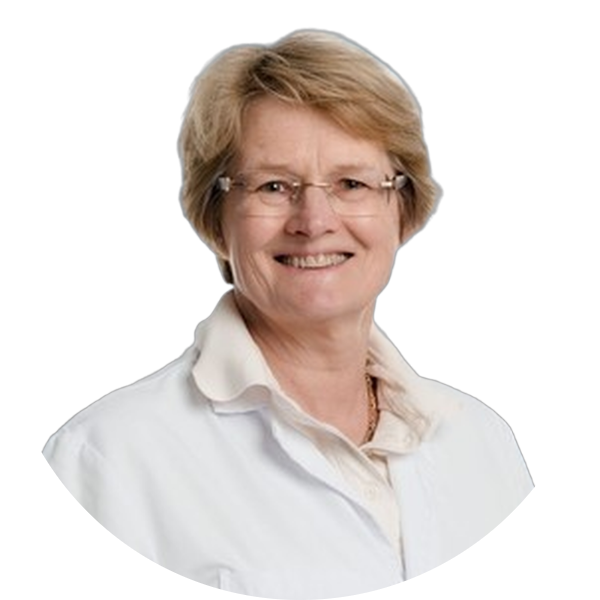
Eric Legius
Eric Legius is a clinician scientist. He was the head of Human Genetics Department of the University of Leuven from 2001-2005 and from 2011- 2016. He was clinical director of the Centre for Human Genetics of the University Hospital of Leuven from 2011 till 2021. His research is targeted towards neurofibromatosis type 1 and related conditions. He contributed successfully towards the understanding of the molecular aetiology of a number of tumours in neurofibromatosis type 1 (NF1). He also contributed to the understanding of the mechanisms of the NF1 microdeletion syndrome. He was involved in the identification of the importance of the polycomb repressor complex type 2 for the development of malignant peripheral nerve sheath tumours in NF1.
In 2007 his research team identified a new condition resembling neurofibromatosis type 1, now known as Legius syndrome (autosomal dominant condition caused by a heterozygous mutation in SPRED1). The group is using animal models to gain insight in the importance of SPRED1 and the RAS-MAPK pathway for autistic behaviour.
https://www.ncbi.nlm.nih.gov/books/NBK47312/
Eric Legius contributed to the revised diagnostic criteria for NF1, Legius syndrome, and the schwannomatoses (NF2-related, SMARCB1-related, LZTR1-related). He was also a senior author on the recent publication of guidelines by the European Reference Network GENTURIS concerning the surveillance and treatment of NF1-related tumours.

Bjarne Udd
Prof Bjarne Udd M.D., Ph.D.
Neuromuscular Research Center, University of Tampere
and Folkhälsan Institute of Genetics, Biomedicum, University of Helsinki
Born in Finland, Dr. Udd received his MD from the University of Berne, Switzerland in 1975, and completed Residency training in Neurology at the University Hospital in Umeå, Sweden, and the University Hospital in Helsinki, Finland.
He received his PhD degree from Helsinki University in 1992 with the thesis on a new type of muscular dystrophy, causing the distal Tibial muscular dystrophy (TMD) in heterozygotes and severe LGMD2J in homozygote patients. With academic appointments (Docent) at Tampere University from 1997 he became the Head of the new program in 2004: Advanced Neuromuscular Diagnostics at the Tampere University Hospital, a nationwide and international quaternary referral center for neuromuscular disease patients with undetermined diagnosis. In 2008 he was appointed Professor of Neurology in Neuromuscular Disorders and the clinical service was upgraded in 2013: Neuromuscular Research Center, Tampere University Hospital . He is currently PI of one research group in Helsinki, at the Folkhälsan Research Center, and one group at Tampere University Hospital. Prof Udd is member of many international research boards in Neuromuscular diseases. His research focuses on very rare neuromuscular diseases: clinical and molecular genetic research on muscular dystrophies, in particular: distal myopathies, rimmed vacuolar myopathies, limb-girdle dystrophies and myotonic dystrophy type 2. Since the first ever description of human muscle disease caused by titin mutations, TMD (Udd myopathy) and LGMD2J, the research efforts have resulted in more than 20 primary descriptions of new muscle diseases many with previously unknown myopathy genes.

Walter van Emde Boas
Walter van Emde Boas (1942) studied medicine at the Municipal University of Amsterdam.
While still a student he joined the staff of the Dutch Central Institute for Brain Research where he was involved in various research projects including the neurophysiology of the visual system and the neurodegenerative effects of hypercholesteraemia. After obtaining a PhD degree on the latter subject (1973) and his medical licence (1974) he trained as a neurologist, paediatric neurologist and clinical neurophysiologist in Amsterdam and Utrecht and for a year held the position of acting head of the paediatric neurology department of the Amsterdam University Medical Centre.
In 1982 he moved to the Epilepsy Clinic “Meer & Bosch”, now part of the Dutch Epilepsy Clinics Foundation (SEIN) as clinical neurophysiologist and consultant paediatric neurologist. In 1985 he was appointed director of the department of Electroencephalography and the Epilepsy Monitoring Unit in Heemstede and –as of 1999 and until December 2002- also of the corresponding departments in the “Heemstaete” clinic in Zwolle.
From Jan. 2003 he acted as senior consultant and supervisor in both clinics and occasionally elsewhere. Following formal retirement in August 2007 he continued his consulting and teaching activities on an on-demand basis until 2019 when he terminated all clinical activities, continuing the teaching work.
As a key member and, for the period 2003-2008, chair of the Dutch Collaborative Epilepsy Surgery Program he was co-responsible for the development and growth of the current flourishing program for adult and paediatric epilepsy surgery in the Netherlands and in 1989 spent 5 months as a visiting scientist at the Montreal Neurological Institute, Canada.
Van Emde Boas is a member of numerous national and international scientific societies, a frequent invited lecturer in the fields of EEG diagnosis and classification of epilepsy and epileptic seizures, seizure semiology, presurgical evaluation and surgical treatment of epilepsy in adults and children and member of the editorial board of a number of international journals. He has been member of numerous (sub)commissions of the International League Against Epilepsy, including the ILAE commission on classification and terminology, (as chair) the taskforce on distance education, and as director and tutor of the Eurepa and Virepa EEG courses. He has received the ILAE “Ambassador of Epilepsy” award, is an honorary member of the Amsterdam Neurologist Society, The Dutch League Against Epilepsy and a number of other Epilepsy organisations or league chapters and is (co)author of over 60 peer reviewed journal papers and book chapters.
In April 2017 he was appointed Officer in the Orde of Oranje-Nassau by His Majesty the King of the Netherlands.

Maja Steinlin
Maja Steinlin is an emerited professor for Paediatric Neurology of the University of Bern, Switzerland. She was the head of Paediatric Neurology in Bern for 23 years.
Her special interests are in paediatric stroke. She initiated the Swiss Neuropaediatric Stroke Registry (SNPSR) and is ever since the PI of it. Since 2000 all children living in Switzerland and suffering an acute stroke are registered in the SNPSR. So far, the register has more than 900 children included and almost 50 publications came out of this data set. Special interest are acute management of stroke in childhood – especially acute recanalization treatments and steroid treatment in focal arteriopathy; the role of inflammation in transient cerebral arteriopathy, reorganisation/rehabilitation and outcome after paediatric stroke. The SNPSR is also taking part in the international paediatric stroke study.
Further areas of interest are cerebellar and neuroophthalmological problems.
Maja Steinlin is a board member of the international Paediatric Stroke Organisation, has been a board member of EPNS for 8 years and is now an honorary member of EPNS. She is a member of the Gesellschaft für Neuropädiatrie, the Swiss Society of Neuropaediatrics and the International Child Neurology Association.

Damjan Osredkar
Assoc. Prof. Damjan Osredkar, MD, PhD is the head of the Pediatric neurology department of the University Children's Hospital in Ljubljana, Slovenia. He also leads the multidisciplinary team treating children with NMD. Assoc. Prof. Osredkar received his degree at the University of Ljubljana in 1999 and his PhD in 2006. He has been awarded with Fulbright Scholarship in 2006 and has worked as a postdoctoral fellow at the University of California San Francisco, USA (2007-2009) and University of Oslo, Norway (2012-2014). His areas of interest include Neuromuscular diseases, Novel treatment options, Gene Therapy, Hypoxic-Ischemic Brain Injury, Neuroprotective treatment.
